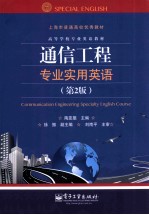

通信工程专业实用英语PDF电子书下载
- 电子书积分:11 积分如何计算积分?
- 作 者:陶亚雄主编;徐振副主编;刘南平主审
- 出 版 社:北京:电子工业出版社
- 出版年份:2014
- ISBN:9787121220753
- 页数:266 页
Unit 1 Brief Introduction of Modern Communication 1
1.1 Text 1
1.1.1 Communication 1
1.1.2 History of Modern Communication 3
1.2 Reading Materials 5
1.3 Exercises 7
1.4 课文参考译文 现代通信简介 9
1.4.1 通信 9
1.4.2 现代通信简史 11
Unit 2 Modulation Techniques 12
2.1 Text 12
2.1.1 Digital&Analog Communication 12
2.1.2 Elements of a Digital Communication System 13
2.1.3 Linear Modulation Techniques—an Overview 14
2.1.4 Non-Linear Modulation 15
2.1.5 FM Modulation Methods 15
2.1.6 FM Detection Techniques 16
2.1.7 Frequency Modulation&Amplitude Modulation 18
2.2 Reading Materials 20
2.3 Exercises 23
2.4 课文参考译文 线性调制技术 25
2.4.1 数字通信与模拟通信 25
2.4.2 数字通信系统的基本组成 25
2.4.3 线性调制技术一览 26
2.4.4 非线性调制 27
2.4.5 频率调制 27
2.4.6 频率解调 28
2.4.7 调频与调幅 29
Unit 3 Coding Techniques 31
3.1 Text 31
3.1.1 Source coding 31
3.1.2 Channel Capacity and Channel Coding 33
3.2 Reading Materials 36
3.3 Exercises 37
3.4 课文参考译文 编码技术 40
3.4.1 信源编码 40
3.4.2 信道容量和信道编码 42
Unit4 MultipleAccess 44
4.1 Text 44
4.1.1 Multi-user Communication System 44
4.1.2 Frequency-Division Multiple Access 45
4.1.3 Time-Division Multiple Access 46
4.1.4 Code-Division Multiple Access 47
4.1.5 Spread Spectrum Modulation 47
4.1.6 Common Types of Spread Spectrum Modulation 49
4.1.7 Other Types of Spread Spectrum Signals 49
4.2 Reading Materials 52
4.3 Exercises 56
4.4 课文参考译文 多址接入 59
4.4.1 多用户通信系统 59
4.4.2 频分多址 60
4.4.3 时分多址 61
4.4.4 码分多址 62
4.4.5 扩频调制 62
4.4.6 常用扩频调制技术 63
4.4.7 其他扩频信号 64
Unit 5 SignalTransmitted in Band-limited Channel 65
5.1 Text 65
5.1.1 Signal Transmitted in Band-limited Channel 65
5.1.2 Partial-response Signals and Systems 66
5.1.3 Synchronization in Band-limited Channel 67
5.2 Reading Materials 70
5.3 Exercises 72
5.4 课文参考译文 带限信道中的信号传输 75
5.4.1 带限信道中的信号传输 75
5.4.2 部分响应信号和部分响应系统 76
5.4.3 带限传输时的同步 77
Unit 6 2G cellular Communication System 79
6.1 Text 79
6.1.1 Cellular in Communication Systems 79
6.1.2 Brief Introduction of GSM 80
6.1.3 Architecture of GSM System 81
6.1.4 Standards of CDMA 82
6.1.5 Basic Parameters of CDMA Communication System 83
6.1.6 Accessing CDMA Communication System 84
6.1.7 Short Message 84
6.2 Reading Materials 88
6.3 Exercises 90
6.4 课文参考译文量2G蜂窝通信系统 93
6.4.1 通信系统中的蜂窝技术 93
6.4.2 GSM简介 94
6.4.3 GSM系统结构 95
6.4.4 CDMA标准 96
6.4.5 CDMA系统基本参数 96
6.4.6 接入CDMA通信系统 97
6.4.7 短消息 97
Unit7 PBX system and Signaling System 99
7.1 Text 99
7.1.1 PBX 99
7.1.2 PBX Systems 99
7.1.3 IP PBX 99
7.1.4 Centrex 100
7.1.5 IP Centrex 100
7.1.6 Signaling System 101
7.2 Reading Matenals 105
7.3 Exercises 107
7.4 课文参考译文 程控交换系统及其信令 110
7.4.1 用户交换机 110
7.4.2 PBX系统 110
7.4.3 IP PBX 110
7.4.4 Centrex 111
7.4.5 IP Centrex 111
7.4.6 信令系统 111
Unit 8 3G Overview 114
8.1 Text 114
8.1.1 Evolution of Mobile Radio Communication 114
8.1.2 3G Standards 114
8.1.3 Comparison of Wireless Communication Systems 117
8.2 Reading Materials 120
8.3 Exercises 123
8.4 课文参考译文3G概览 124
8.4.1 移动无线通信系统的演进 124
8.4.2 3G标准 125
8.4.3 无线通信系统比较 127
Unit 9 Internet ofThings 129
9.1 Text 129
9.1.1 Introduction of IoT 129
9.1.2 Smart City 130
9.1.3 Application of IoT—Control 4 Hospitality Solutions 131
9.2 Reading Materials 133
9.3 Exercises 134
9.4 课文参考译文 物联网 136
9.4.1 物联网概述 136
9.4.2 智慧城市 137
9.4.3 物联网的应用———Control 4酒店解决方案 138
Unit 10 4G Overview 139
10.1 Text 139
10.1.1 Introduction of 4G 139
10.1.2 Evolution from 1 G to 4G 140
10.1.3 LTE 141
10.1.4 WiMAX 142
10.2 Reading Materials 143
10.3 Exercises 144
10.4 课文参考译文4G概述 146
10.4.1 4G介绍 146
10.4.2 1 G到4G的演进 147
10.4.3 LTE 148
10.4.4 WiMAX 148
Unit 11 Circuit-Switched Network and Packet-Switched Networks 150
11.1 Text 150
11.1.1 Circuit-switched networks 150
11.1.2 Packet-Switched Networks 150
11.1.3 Details of Packet Switching 151
11.1.4 Packet Switching&Circuit Switching 152
11.2 Reading Materials 154
11.3 Exercises 157
11.4 课文参考译文 电路交换和分组交换 159
11.4.1 电路交换 159
11.4.2 分组交换 159
11.4.3 分组交换的一些细节 160
11.4.4 分组交换与电路交换性能对比 160
Unit 12 An Overview of Fiber Optic Technology 162
12.1 Text 162
12.1.1 Fiber Optic Principles 162
12.1.2 Fiber Optic Characteristics 162
12.1.3 Types of Fibers 163
12.1.4 Advantages of Fiber Optic Cables 164
12.2 Reading Materials 167
12.3 Exercises 170
12.4 课文参考译文 光纤技术概览 171
12.4.1 光纤的原理 171
12.4.2 光纤的特性 172
12.4.3 光纤的类型 172
12.4.4 光缆的优势 173
Unit 13 Voice over InternetProtocol 175
13.1 Text 175
13.1.1 Protocols Used in VoIP Services 175
13.1.2 How does VoIP Work? 176
13.1.3 Handoff Strategies 177
13.1.4 VoIP on 3G will beat Wi-Fi 179
13.2 Reading Materials 180
13.3 Exercises 183
13.4 课文参考译文 基于IP的语音传输 185
13.4.1 VoIP中的协议 186
13.4.2 VoIP是如何运作的? 187
13.4.3 切换策略 187
13.4.4 3G VoIP将击败W i-Fi 188
Unit 14 ARM Technique and Embedded Systems 189
14.1 Text 189
14.1.1 ARM Technique 189
14.1.2 Embedded Systems 190
14.2 Reading Material 192
14.3 Exercises 193
14.4 课文参考译文ARM技术与嵌入式系统 195
14.4.1 ARM技术 195
14.4.2 嵌入式系统 196
Unit 15 Commonsensible Concepts 198
15.1 Text 198
15.2 Reading Materials 209
15.3 Exercises 211
15.4 课文参考译文 基本概念 214
Unit 16 Automotive Electronics 220
16.1 Text 220
16.1.1 Engine Electronics 220
16.1.2 Automotive Navigation System 221
16.1.3 Infotainment systems 222
16.1.4 Electric Vehicle 222
16.2 Reading Material 223
16.3 Exercises 225
16.4 参考译文 汽车电子技术 226
16.4.1 发动机电子设备 227
16.4.2 汽车导航系统 227
16.4.3 车载信息娱乐系统 228
16.4.4 电动汽车 228
附录A现代通信常用词组和缩写 229
附录B常见国际电信组织机构 250
附录C习题答案 251
参考文献 266
- 《计算机网络与通信基础》谢雨飞,田启川编著 2019
- 《高级英语阅读与听说教程》刘秀梅编著 2019
- 《思维导图 超好用英语单词书》(中国)王若琳 2019
- 《初中生英语作文 提高篇》清瑶主编 2019
- 《培生高级英语语法 练习册》培生教育 2019
- 《指向核心素养 北京十一学校名师教学设计 英语 七年级 上 配人教版》周志英总主编 2019
- 《365奇趣英语乐园 世界民间故事》爱思得图书国际企业 2018
- 《新课标背景下英语教学理论与教学活动研究》应丽君 2018
- 《幼儿英语游戏活动指导与实训》苏小菊,任晓琴主编;颜晓芳,覃静,谢恬恬,钟博维副主编 2020
- 《剑桥国际英语写作教程 段落写作》(美)吉尔·辛格尔顿(Jill Shingleton)编著 2019
- 《电子测量与仪器》人力资源和社会保障部教材办公室组织编写 2009
- 《少儿电子琴入门教程 双色图解版》灌木文化 2019
- 《指向核心素养 北京十一学校名师教学设计 英语 七年级 上 配人教版》周志英总主编 2019
- 《北京生态环境保护》《北京环境保护丛书》编委会编著 2018
- 《指向核心素养 北京十一学校名师教学设计 英语 九年级 上 配人教版》周志英总主编 2019
- 《通信电子电路原理及仿真设计》叶建芳 2019
- 《高等院校旅游专业系列教材 旅游企业岗位培训系列教材 新编北京导游英语》杨昆,鄢莉,谭明华 2019
- 《电子应用技术项目教程 第3版》王彰云 2019
- 《中国十大出版家》王震,贺越明著 1991
- 《近代民营出版机构的英语函授教育 以“商务、中华、开明”函授学校为个案 1915年-1946年版》丁伟 2017
